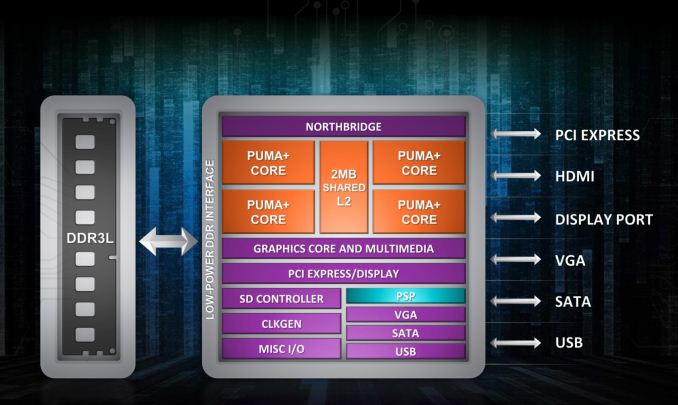AMD Beema/Mullins Architecture & Performance Preview
by Anand Lal Shimpi on April 29, 2014 12:00 AM ESTFinal Words
Despite no significant changes to the architecture or manufacturing process, AMD’s 2014 updates to its entry level and low power silicon are substantial. We finally have AMD silicon, built around a non-Bulldozer architecture, that seem to have turbo capabilities comparable to Intel’s. The result is a completely different performance profile. While AMD’s Jaguar cores in Kabini and Temash were easily outperformed by Intel’s Bay Trail, Puma+ pulls ahead. AMD continues to hold a substantial GPU performance advantage as well.
The gains in performance come while decreasing platform power. You can now have roughly the same performance as AMD offered last year in a 15W entry level notebook part, in a 4.5W TDP (2.8W SDP) tablet SKU. That’s seriously impressive.
The progress AMD made in a year with Beema and Mullins shows just how time constrained the team(s) were with bringing Kabini and Temash to market in 2013. While both of those SoCs were quite successful for AMD, I expect that at some point AMD won’t be allowed two years to fully polish a single design.
The big unknown is how these new SoCs stack up against Bay Trail when it comes to power consumption. From a performance standpoint at the very high end they are faster, but we’ll have to wait until we can get our hands on shipping devices before we know the full story when it comes to battery life. AMD expects to see Beema and Mullins designs show up over the next 1 - 2 quarters, with some designs shipping in the coming weeks to specific regions.
The other thing we need to see is a real Android strategy from AMD. Mullins seems like a good fit for a high performance Android tablet, but today AMD’s native OS strategy is exclusively Windows. I don’t think it’ll stay that way for long, but AMD has yet to give us any indication of when it’ll change.
And if I’m asking for things I want to see from AMD, you can add a PoP package and idle power that’s competitive with the likes of Apple and Qualcomm. AMD clearly came a long way over the past couple of years, but there’s still more progress to be made.











82 Comments
View All Comments
H2323 - Tuesday, April 29, 2014 - link
everyone else is saying glofloAnand Lal Shimpi - Tuesday, April 29, 2014 - link
It's GF, I've updated the piece :)Take care,
Anand
raghu78 - Tuesday, April 29, 2014 - link
ananddo you have information on the exact GF 28 nm process used for manufacturing Beema and Mullins. Is it GF 28 SHP (Super high performance) or GF 28 SLP (Super Low Power).
Da W - Tuesday, April 29, 2014 - link
Yeah but current gen console have PC-like architecture because developper wanted easier PC porting. Most will already port their game for the Mullins/Beema architecture anyway.Da W - Tuesday, April 29, 2014 - link
Man, i'm dying for an AMD-powered surface mini with Xbox/PC streaming capabilities like Nvidia Shield! MAKE IT HAPPEN!H2323 - Tuesday, April 29, 2014 - link
That is a real possibility, might be one of there two semi-custom wins from earningslittlebitstrouds - Tuesday, April 29, 2014 - link
I wish you would provide the Sony Vegas render test in anything that will run it. I'm looking for a tablet that's a dailies workhorse.Dawgmatix - Tuesday, April 29, 2014 - link
Any idea on if this will support OpenCL 2.0?MarionHNunn - Tuesday, April 29, 2014 - link
I think it will put to bed the calls for cat cores to replace AMD's higher powered offerings. Yes, we're past K8 performance levels now, but Llano and Trinity (let alone Richland/Kaveri) still have it beat. You'd need some serious clock speeds to get decent performance and it's the wrong silicon for that. http://sn.im/28v1ckwwow&wow - Tuesday, April 29, 2014 - link
"Mullins seems like a good fit for a high performance Android tablet, but ..."Mullins seems like a good fit for a high performance Android tablet, but HOW BIG IS THE HIGH PERFORMANCE ANDROID MARKET?
With limited resources and wafer supplies, led by Rory Read with business sense, AMD has been focusing on making money (the #1 common business sense) instead of BLINDLY COMPETING IN EVERY MARKET for the sake of conpeting and failing like before. Every business is a good business is a sales talk, but in reality not every business is a good business and pick the proper ones!